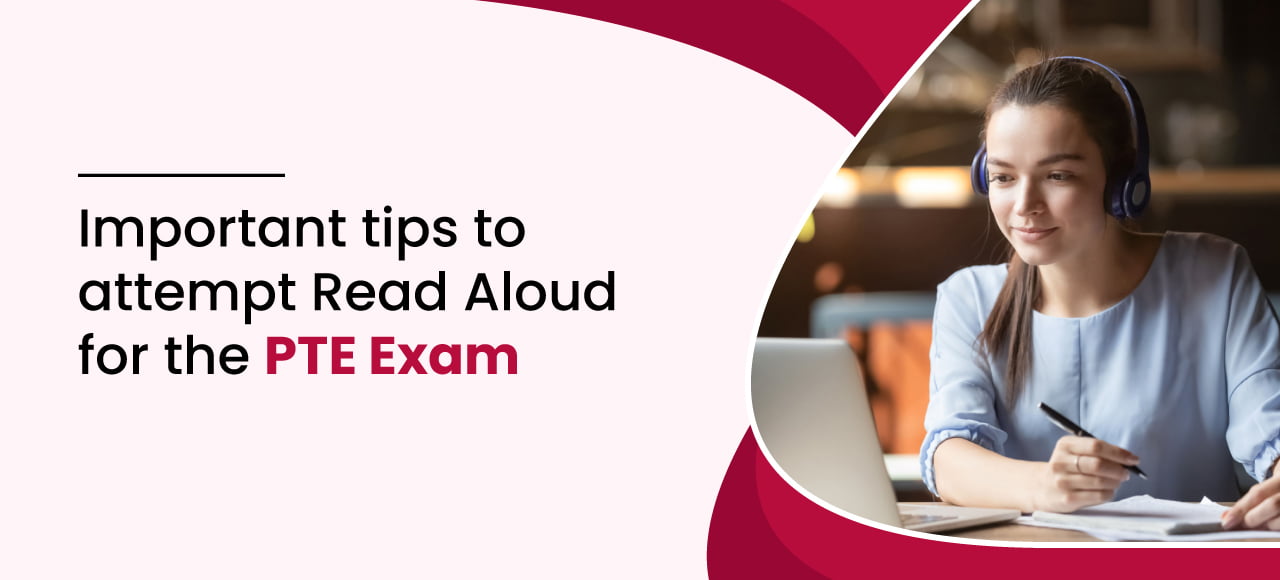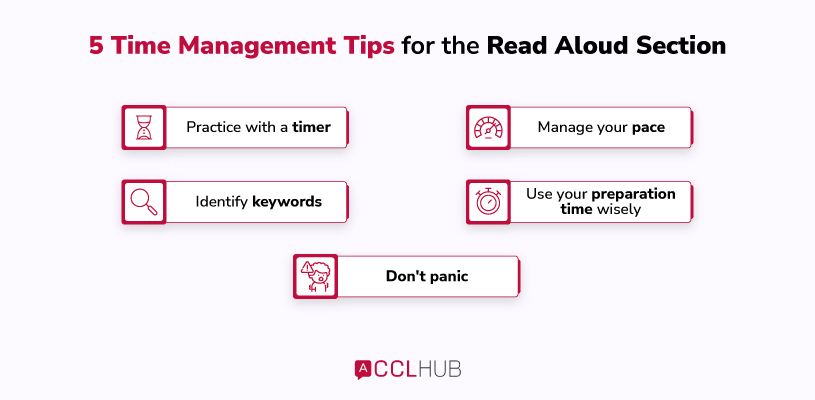
Tips to remember while attempting Read Aloud for the PTE Exam
Reading aloud is a vital skill you’ll need to develop as a candidate for the PTE exam. You will need some tips to attempt Read Aloud for the PTE Exam to score what you desire.
After all, reading is one of the most critical aspects of language learning, and you never want to limit your exposure to this skill by leaving it up to chance or memory alone. To do this, you’ll need a few solid tips that will allow you to get the most out of your time when trying to read aloud for the PTE exam.
Along with some practical tips and secrets for the PTE exam, In this article, we’ll discuss some of the essential tips to attempt Read Aloud for the PTE Exam so that you end up with positive results rather than frustration.
📑 Editors Recommendation: What makes PTE different from other English language Exams?
Understanding the Read Aloud section of the PTE Exam
Understanding the Read Aloud section of the PTE Exam is crucial for achieving a good score in this part of the exam and also for what to expect on the PTE test day. In this section, the candidate must read a short text out loud, which is recorded for evaluation.
The text can be academic or non-academic but usually contains around 60 words. However, It is essential to understand the scoring criteria for this section, which are based on the following factors:
1. Pronunciation
The accuracy and clarity of the candidate’s pronunciation are evaluated. The candidate must enunciate each word and use the correct stress and intonation.
2. Fluency
The ability to read the text smoothly and without pauses is evaluated. The candidate needs to maintain a consistent pace and avoid hesitations or stumbling.
3. Content
The candidate’s ability to understand and convey the meaning of the text is evaluated. The candidate needs to comprehend and read the text with appropriate expression and emphasis.
To perform well in this section, candidates must focus on pronunciation, fluency, and comprehension. Furthermore, you should also pay attention to their pacing and intonation, as this can affect their overall score.
It is also important to practice with different types of texts, including academic and non-academic passages, to be prepared for any question in the exam.
6 Essential Tips to Attempt Read Aloud for the PTE Exam
The Read-Aloud section of the PTE Exam is an important part of the test that requires careful preparation and practice. Some tips to attempt Read Aloud for the PTE Exam are:
1. Start with short reading sessions
Reading aloud is a skill that will require consistent practice if you want to see any real, lasting results. Also, break your sessions into smaller, more frequent chunks and start practicing for rewarding results.
If you can fit in a 30-minute break every few hours of your practice, use this time for recess. It’s easy to get caught up in the excitement of reading aloud for the first time and forget that it takes consistent effort to make this happen.
2. Feel more comfortable
One of the most common mistakes students make when trying to read aloud for the exam is speaking in a high, nervous tone that makes them feel extremely self-conscious and insecure.
Moreover, If you feel self-conscious when reading aloud for the exam, you will feel self-conscious in almost all your social situations and during your exam practice. You probably don’t want that to happen.
Therefore, whether practicing in your home or at a private PTE center, try to lower your tone to give yourself the most comfort and security when speaking. This will allow you to focus more on what you’re saying and less on how you’re saying it.
3. Practice reading aloud by starting with small sentences
Fluency plays a crucial role in achieving a good score. A good way to build your fluency is to start practicing smaller sentences first and slowly upgrading yourself to medium and long sentences.
Once you speak the smaller sentences fluently enough, you can move on to medium and long sentences. Furthermore, you can get all the PTE course materials, mock tests, and online classes to achieve your desired score at CCLHUB.
4. Practice learning common vocabulary
You can learn pronunciation and meaning from the IELTS and PTE academic word lists. Also, try making them work in different forms of sentences.
Likewise, vocabulary is as important as fluency in the read-aloud section. Hence, constant practice will make you more confident when you find any complex text in the exam.
5. Record yourself
If you can get an individual, even better, your friend, who is more fluent in English, make them listen to your recordings and get suggestions to improve. Always practice with authentic PTE course materials available on the web.
Furthermore, you should always record your answers in the read-aloud section and listen to them, focusing on finding flaws and improving on them.
6. Don’t be afraid to ask for help
Read aloud for the exam is meant to be practiced, so don’t be afraid to ask for help when needed. This help can come from getting extra practice, having an instructor attend your sessions, or getting additional practice material.
There’s no shame in asking for help if you struggle with reading for the exam. Especially when you feel like you’re falling behind in the read-aloud section, you should not be afraid to ask for help from anyone willing to help you.
Time Management Tips for the Read Aloud Section

Time management is critical for the PTE exam, as candidates are given limited time to finish their sections. Following are 5 top time management tips for the Read Aloud section:
1. Practice with a timer
One of the best ways to prepare for the timer of the Read Aloud section is to practice with a timer. Set the timer for the allotted time for the exam section, and try to complete as many questions as possible within that time frame.
A timer will help you get used to the pace you must maintain during the exam.
2. Manage your pace
When practicing, it’s important to manage your pace carefully. Don’t rush through the questions or sentences, but don’t take too much time on any question. Ensure you are moving consistently and comfortable with the speed you read aloud.
3. Identify keywords
Identify the keywords in each sentence or passage when practicing the Read Aloud section. This will help you understand the structure and meaning of the text more quickly, allowing you to read more efficiently and accurately.
4. Use your preparation time wisely
Before starting the Read Aloud section, you’ll be given some preparation time to read the text silently and prepare for the recording. Use this time wisely to identify challenging words or phrases, and practice the pronunciation to be confident when recording.
5. Don’t panic
Finally, it’s important to avoid panic if you feel you’re running out of time or can’t complete all the questions. Remember that it’s better to answer fewer questions correctly than to rush through and make mistakes. Take a deep breath, stay calm, and do your best with your time.
Importance of building vocabulary for the Read Aloud section
Building vocabulary is crucial for success in the Read Aloud section of the PTE Exam. This section requires candidates to read a short text aloud while being recorded, and it is assessed based on several factors, including pronunciation, fluency, and intonation.
Having a rich and diverse vocabulary can help candidates in several ways. First, it allows them to understand the text better, which helps them read it more fluently and with better pronunciation. Secondly, a broad vocabulary enables candidates to use synonyms and paraphrasing when encountering unfamiliar words in the text, making it easier to convey the meaning accurately.
However, reading extensively is one of the best ways to build vocabulary. This can include reading books, newspapers, magazines, and online articles, listening to podcasts, and watching videos on various topics. Candidates should also practice using new vocabulary in context by writing sentences and paragraphs incorporating these new words and phrases.
In summary, building vocabulary is essential for success in the Read Aloud section of the PTE Exam. Candidates should focus on developing a broad and diverse vocabulary by reading extensively and practicing using new words in context. Doing so can improve their overall performance and increase their chances of success in the exam.
🔔Learn more: Can you take PTE Academic online? All you need to know about it
Conclusion
In conclusion, the Read Aloud section of the PTE exam can be challenging for many candidates. However, with consistent practice and the right techniques, anyone can master this skill and score high on the exam.
Building vocabulary for the Read Aloud section is important, as it plays a crucial role in achieving a good score. A wide range of vocabulary helps enhance fluency and allows candidates to tackle complex texts confidently.
Furthermore, candidates must know this section’s specific requirements and expectations to perform well. Having said that, with consistent practice, dedication, and a positive attitude, anyone can excel in the Read Aloud section of the PTE exam and achieve their desired score.
You can also prepare for the PTE exam at home with numerous materials available on the internet.
Good luck!
FAQ
The Read-Aloud section in the PTE Exam lasts for around 30-40 seconds. You will have enough time to read the given text and prepare to record your answer.
Scores for the Read Aloud section in the PTE Exam are calculated based on your pronunciation, fluency, and overall oral communication skills. The automated scoring system evaluates these factors based on the recording you submit and assigns you a score on a scale of 10 to 90.
No, you cannot repeat the text in the Read Aloud section of the PTE Exam if you make a mistake. You must continue reading and completing the task to the best of your ability. However, if you realize your mistake after you’ve completed the task, you can mention it in the ‘Feedback’ section provided after the task.
You can practice the Read Aloud section before taking the PTE Exam. Several resources are available online, including mock tests and sample questions, that you can use to prepare yourself for this section. You can also enroll in PTE coaching classes to get expert guidance and improve your skills.



